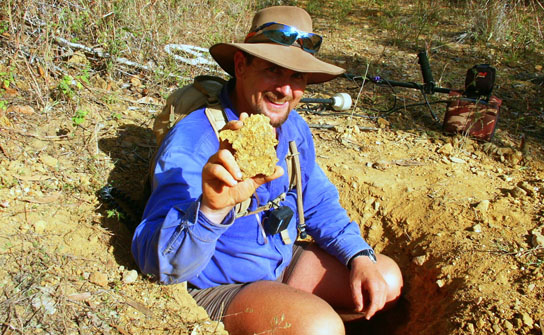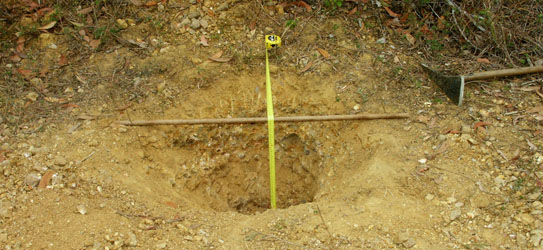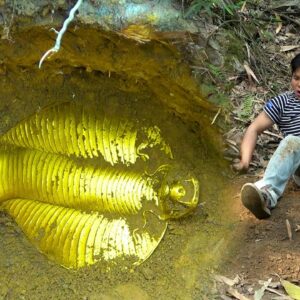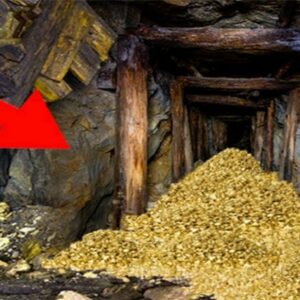There are some basic rules that should be at the forefront of your mind when detecting for gold, probably the most important one being to dig everything. No one can accurately determine if a signal is gold just by listening to the signal response, especially if the target is large or close to the surface of the ground. There is another side to gold prospecting with a metal detector that requires a different approach, this is often dictated by expediency due to time restraints and in a lot of cases an attempt to maintain some sanity, these areas are often in and around old diggings where there is a lot of trash from both modern and Old Timers.

As most of you know when the detector heralds a target there are a number of factors indicated by the audio that will allow you to make an informed decision on the likelihood of the depth and size of the target. In this discussion let’s assume I’m talking about Monoloop coils in combination with the
GPX 5000, however most of what I’m about to say can correlate to Double-D coils as well.
The size and depth of a target determines the way it behaves when it’s exposed to the transmit field of the detector. It is the eddy currents excited in the target by the transmit field that we are listening carefully for during the GPX 5000’s receive on-time, the deeper the target, the fainter the target audio will be due to the weaker field coming back off the target.

You can, to some extent, tell if a target is further away from the coil by listening carefully when sweeping the coil in a controlled manner. This is done in a number of ways, one being locating the target directly under the coil then stepping back into clean non signal ground before proceeding to sweep carefully forward back into the target zone paying attention to the way the detector responds relative to the coil position. The other way is to progressively lift and swing the coil above the target area listening to how long the response holds in there. A deep target will have a broader response zone relative to the centre of the coil, whereas a shallow small target will go from having a more localised response relative to its position to the closest part of the winding to a broader fainter response as the coil is pulled away. I should point out here the distance of the target from the coil is relative to size, so this method applies to all target sizes.
A deep target can also have a ground noise like zone well outside the centre of detection, particularly on very large targets. I use a comparative method of familiarising myself with the local ground noise response in the immediate vicinity then bring the coil back into the target zone when trying to make a determination about a potential target or ground noise response.
Getting good at recognising the way a target responds relative to distance from the coil can go a long way in allowing you to concentrate only on targets that are buried saving huge amounts of time in trashy areas. I rely on the law of averages in situations like this, in deeper ground the chances of a trash target being buried are far less than the likelihood of there being good targets on the surface. If there are good targets on the surface mixed in with trash then you probably need to use a discrimination method of detection and concentrate more on the surface targets ignoring the deeper responses.
A deep target will have a soft mellow sound that does not change much if the coil is lifted slightly away. The response will be consistent all over the coil face, because the whole coil is responding, not the localised edge of the winding. Having a controlled even sweep will help greatly in bringing up the sound of a target, the whole coil needs to be exposed evenly to maximize the signal which is very important if you want to generate a recognisable response in the audio. Tilting the coil on a deep target can cause the response to disappear whereas a shallow small target that is mimicking a deep larger target will still respond to the edge field of the coil.

Another good technique to use is visualisation. Practice putting a known visible target on the surface of the ground and familiarise yourself with where the coil edge responds, once you have this procedure finetuned you can then easily visualise a particular place on the coil when targeting unseen signals. This method helps greatly in making an informed decision on targets at depth as well as pinpointing chores. The ability to memorise a signal’s behaviour and cross referencing with the way it behaves at a later date when experimenting with coil sweep speed and angle is very important, however you should always trust your gut instinct on your original investigations especially prior to digging.
To sum up; get good at visualisation, listen to the response relative to the coil sweep position and commit it to memory. Be prepared to experiment with the undisturbed response for as long as necessary. A deep signal will be broad and faint and at its loudest point will be directly under the centre of the coil, a shallow target will try to mimic a deep target, but can be ‘found out’ by using the edge of the coil to sneak up on the signal. Get good at keeping your coil as parallel as possible to the ground, a deep target needs a good even exposure to the whole winding to manifest properly. An accurate sweep will assist greatly in this. Learn the nuances of the localised ground noise/response when determining a faint signal, sometimes deeply buried targets sound just like a very broad ground noise.

Lastly be patient, the methods described can be used very effectively in areas that have been pounded to death or where other operators have given up in disgust due to the amount of trash. I’m more than happy to allow myself a couple of hours in problematic deep ground locations like this knowing full well I might only get one good signal in an outing, however quite often that one good signal is very well worth having.





